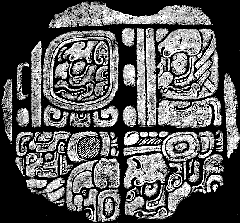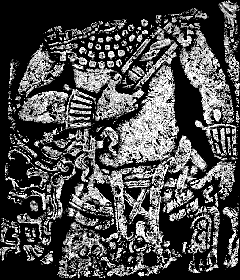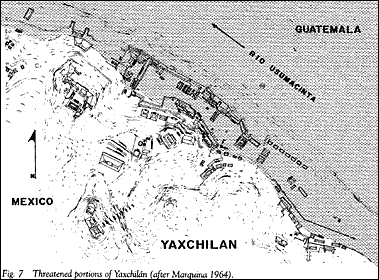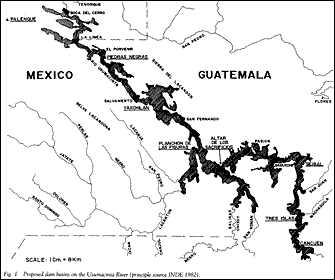
Posted August 13, 2002
|
The impending construction of a hydroelectric dam on the Usumacinta River has once again raised the prospect of flooding major archaeological sites. Even vital centers of ongoing research such as Piedras Negras may be affected, as well as the World Monuments site of Yaxchilan, as reported by the Mexican periodical La Reforma.
These priceless monuments of Maya civilization and others yet unexplored would be covered by an artifical lake some 16 billion cubic meters in extent. Also threatened are a rich variety of precious hardwoods and the last remaining jaguars and parrots in the riverside jungles of Mexico and Guatemala. A project of multiple dams was almost put into effect in 1987 and again in 1992 only to be canceled due to the outcry over irreperable damages to Mexico's richest zone of biodiversity and archaeological remains. The illustrations in this report are from a presentation by Jeffrey Wilkerson (1991), who raised the alarm at the Fifth and Sixth Palenque Round Tables. |
|
Called "Boca de Cerro", the current hydroelectric project would create a mammoth artificial lake by damming the gap in the Chiapas highlands where the Usumascinta emerges onto the Tabasco Plain.
The impact of the project was confirmed by Rubén Regnier, a spokesman for National Institute of Anthropology and History (INAH), which is in charge of Mexico's archaeological patrimony. Regnier disclosed an agreement with Mexico's Federal Electricity Commission by which INAH would minimize delays in the construction of substations and power lines by suggesting modifications due to the accidental discovery of archaeological remains. Laura Pescador, INAH director for the state of Chiapas, told La Prensa that a salvage operation would be necessary for the area to be flooded by the dam, which includes a number of important archaeological sites that have not yet been explored. The salvage operation would attempt to recover as much information as possible before the sites disappear beneath the water. In another newspaper interview, Luis Alberto López Wario, INAH's Director of Salvage Archaeology, maintained that it was "impossible" that INAH would give its approval to the flooding of Yaxchilan, but he readily conceded that any number of other sites would be affected, among them Chinikiha, which has a ballcourt structure and unexplored mounds. Chinikiha has an important place in Maya history and art. The rubbings by Merle Greene Robertson of pieces looted from Chinikiha (below) demonstrate the high quality of sculpture produced at the site during the Classic Period. The possibility of finding more such works, as well as glyphs casting a light on the complex details of politics and warfare in the region, will be lost forever. |

| 
|
|
López Wario indicated that in a previous study he had located approximately 25 archaeological sites in the Boca del Cerro canyon. He pointed to the strategic importance since Olmec times of sites controling access to the Usumacinta.
The threat to Yaxchilan was based on calculations provided by Greenpeace and related by Norma Barbacci of the World Monuments Fund, which lists Yaxchilan as one of the world's one hundred most threatened monuments. Alfonso Morales, the archaeologist whose team has made many of the recent discoveries at Palenque in Chiapas, has received reliable information that a group of engineers have been on the Usumacinta inspecting potential dam sites and water levels at specific points. They have started work on a new road to the river that branches off from the highway to Frontera Corozal, to be used during the construction of the dams. Morales himself went to visit the local head of the Federal Electricity Commission to ask him what he knew. He confirmed that dams were planned but maintained that they would be "low". When asked how low, he said that he would try to find out. He also had some specific knowledge of some of the areas that would be affected by the dams. Morales and Julia Miller of the Palenque Cross Group Project were in Yaxchilan recently and talked to people in Frontera Corozal who will be dramatically affected by the dam project, which is part of a larger development scheme called the Plan Puebla Panamá (PPP). Morales and Miller were told there that one of the plans in the PPP is to build a road directly to Yaxchilan. Miller writes, "The trip to Yaxchilan really stressed to us the enormous loss that will be incurred by this project. We saw a wider variety of animals, birds, and reptiles than usual. Alfonso says that it is the first time in 25 years that he has seen scarlet macaws in the area (we saw four macaws feeding in a tree near Structure 33). We also saw both howler and spider monkeys, a coatimundi, alligators, and lots of birds along the river." |
home

